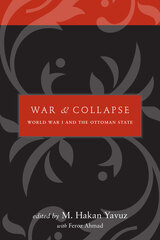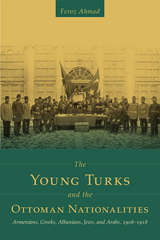3 books about 1909-1918

Haim Nahum
A Sephardic Chief Rabbi in Politics, 1892-1923
Esther Benbassa
University of Alabama Press, 1995
First published in French by the Presses du Centre National de la Recherche ScientiÞque in 1990, this book relates the history of Turkish Jewry during the last decades of the Ottoman empire, as told through the life and work of Haim Nahum, the Chief Rabbi of the Ottoman empire from 1909 to 1920.
[more]

War and Collapse
World War I and the Ottoman State
Edited by M. Hakan Yavuz with Feroz Ahmad
University of Utah Press, 2015
War and Collapse is the third and final volume in a series that covers the last years of the Ottoman Empire. This book stems from a three-day international conference held in May 2012 at which scholars examined the causes and consequences of World War I, with a distinctive focus on how these events pertained to the Ottoman state and society. Fifty-three scholars—both new and established—contributed to this collection, with the goal of explaining what happened within the Ottoman Empire before and during WWI and how ethnic and national groups constructed these events to enhance their identities, promote their interests, and situate their collective selves in the international system. The chapters provide insight into the mindset and experiences of Ottoman peoples from the end of the Balkan Wars through the end of World War I, showing how earlier events set in motion the Ottoman response to the war and how continued engagement in conflict had devastating, irreversible effects on Ottoman society. The articles in this volume include a wide variety of ideas and points of view, thus presenting a comprehensive picture of the events.
[more]

The Young Turks and the Ottoman Nationalities
Armenians, Greeks, Albanians, Jews, and Arabs, 1908–1918
Feroz Ahmad
University of Utah Press, 2014
The years 1908 to 1918 are frequently viewed as the period when the Ottoman Empire fell into decline, but in this volume, Feroz Ahmad argues that the Empire was not in decline but instead had come face to face with a widespread process of decolonization. Its colonies, stimulated by the idea of nationalism, sought to liberate themselves, sometimes with the help of the Great Powers of Europe, who in turn saw these rebellions as an opportunity to expand their own empires. While these ethno-nationalist movements have often been described in terms of Ottoman oppressor versus conspiring nationalists, here they are presented as part of a broad historical process.
Ahmad holds that nationalism was introduced into the Ottoman Empire during the French Revolution, providing kindling for the struggles that later emerged. Setting the stage with this nineteenth-century background, Ahmad then examines each Ottoman nationality in the wake of the restoration of the Ottoman constitution in 1908. Officially known as the Committee of Union and Progress (CUP), the Young Turks made up a nationalist political party that ruled the Ottoman Empire from 1908 until the end of World War I. Ahmad illuminates the relationships and conflicts between the Young Turks and the Greek, Armenian, Albanian, Jewish, and Arab ethnic groups during this period. Placing these nationalities in their historical context, he shows their relationships not only to the Young Turks but also to one anotherno other single book has attempted to look closely at all of these connections.
Anyone interested in understanding the roots of current-day relations in the Balkans and Middle East will find this book very informative. Clearly organized and written, the book will enlighten both readers and scholars.
Ahmad holds that nationalism was introduced into the Ottoman Empire during the French Revolution, providing kindling for the struggles that later emerged. Setting the stage with this nineteenth-century background, Ahmad then examines each Ottoman nationality in the wake of the restoration of the Ottoman constitution in 1908. Officially known as the Committee of Union and Progress (CUP), the Young Turks made up a nationalist political party that ruled the Ottoman Empire from 1908 until the end of World War I. Ahmad illuminates the relationships and conflicts between the Young Turks and the Greek, Armenian, Albanian, Jewish, and Arab ethnic groups during this period. Placing these nationalities in their historical context, he shows their relationships not only to the Young Turks but also to one anotherno other single book has attempted to look closely at all of these connections.
Anyone interested in understanding the roots of current-day relations in the Balkans and Middle East will find this book very informative. Clearly organized and written, the book will enlighten both readers and scholars.
[more]
READERS
Browse our collection.
PUBLISHERS
See BiblioVault's publisher services.
STUDENT SERVICES
Files for college accessibility offices.
UChicago Accessibility Resources
home | accessibility | search | about | contact us
BiblioVault ® 2001 - 2024
The University of Chicago Press









